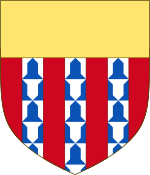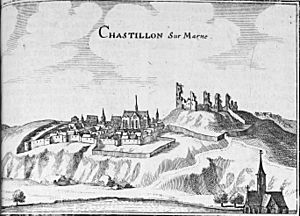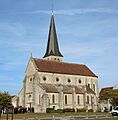Walter III of Châtillon facts for kids
Quick facts for kids
Walter III of Châtillon
|
|
|---|---|
| Lord of Châtillon | |
 |
|
| Reign | 1191–1219 |
| Predecessor | Guy III of Châtillon |
| Successor | Guy IV of Châtillon-Saint-Pol Hugh of Châtillon-Saint-Pol |
| Other titles | Butler of Champagne Seneschal of Burgundy |
| Born | c. 1166 |
| Died | October 1219 |
| Noble family | House of Châtillon |
| Spouse(s) | Elisabeth of Saint-Pol |
| Issue | Guy IV of Châtillon-Saint-Pol Hugh of Châtillon-Saint-Pol Béatrix de Châtillon-Saint-Pol Eustachia de Châtillon-Saint-Pol |
| Father | Guy II of Châtillon |
| Mother | Adèle of Dreux |
Walter III of Châtillon (also known as Gaucher III de Châtillon) was a brave French knight and an important leader. He lived a long time ago, from about 1166 to 1219. He was the Lord of several places like Châtillon, Montjay, and Pierrefonds. Through his marriage, he also became the Count of Saint-Pol. Walter held important jobs, such as the Butler of Champagne and the Seneschal of Burgundy. These roles meant he helped manage royal lands and armies.
Contents
Biography
Early Life and Family
Walter was born around 1166. He was the second son of Guy II of Châtillon and Adèle of Dreux. When his father died in 1170, Walter's older brother, Guy III, became the Lord of Châtillon. Walter helped his brother with his duties. His youngest brother, Robert, chose a church career. Robert became the bishop of Laon in 1210 and served until his death in 1215.
A Knight in the Crusades
In 1189, Walter and his older brother Guy joined the Third Crusade. This was a big journey to the Holy Land. They arrived at the siege of Acre with King Philip Augustus on March 30, 1191. Sadly, Guy III of Châtillon died during the fighting. This meant Walter became the new Lord of Châtillon.
After the city of Acre was captured and the French King left, Walter stayed in the Holy Land. He fought bravely in the battle of Arsuf and the battle of Jaffa. He likely returned to Châtillon in late 1192.
Becoming a Count and Important Roles
Walter's skills in battle during the Crusade were noticed. Because of his bravery, he was given important positions. He was named the Butler of Champagne. Later, in 1196, he became the Seneschal of Burgundy. These were high-ranking jobs in the king's service.
In 1196, Walter married Elisabeth of Saint-Pol. She was the daughter and heir of Hugh IV of Campdavaine, the Count of Saint-Pol. In 1205, Walter took over from his father-in-law and became the Count of Saint-Pol. Walter and Elisabeth also started a new town together. They named it Villeneuve-le-Comte, and it was built in the forest of Crécy-la-Chapelle.
Fighting for France
In 1203, Walter joined the French army. He fought alongside Duke Odo III of Burgundy and Guy II of Dampierre. They were fighting to take over Normandy from the English King John Lackland. Walter fought in the Siege of Château Gaillard. He also helped capture important cities like Falaise, Caen, Bayeux, and Rouen.
In 1209, Walter took part in the Albigensian Crusade. This was another military campaign. He fought at the siege of Béziers and then at Carcassonne. His fighting skills impressed the king. The king then gave Walter an army to fight against the English King in Brittany.
The Battle of Bouvines
In 1213, Walter fought for the King again in Flanders and Hainaut. He helped capture the cities of Tournai and Mortagne. Before the famous battle of Bouvines on July 27, 1214, some French lords wondered if Walter was truly loyal. He famously replied that "on that day the king would find in him a good traitor." This meant he would fight so hard, it would seem like he was betraying the enemy.
During the battle, Walter charged through enemy lines many times. He caused a lot of trouble for the opposing army. A writer named William the Breton said that Walter struck down everyone in his path. He even cut a hole through the enemy's formation. Walter was a very experienced fighter by this time. William the Breton also wrote that Walter took a break after fighting for a long time. But when he saw one of his knights being attacked, he rode back in to save him. He was hit by 12 lances, but his armor likely protected him. Walter kept fighting. His heroic actions in battle made him a legend. Poems about his deeds were written many years after his death.
Later Years and Legacy
During the war of the Succession of Champagne, Walter supported Countess-Regent Blanche of Navarre and her son Theobald. They were fighting against another claimant to the throne, Erard of Brienne-Ramerupt.
In 1219, Walter joined a Crusade for the third time in his life. He returned to the Albigensian Crusade. He fought at the sieges of Marmande and then Toulouse. Walter died in November 1219, probably during a battle.
William the Breton, who lived at the same time as Walter, described him as "the bravest in arms of his time." Walter also appears in William Shakespeare's play about King John.
Family
In 1196, Walter married Elisabeth of Saint-Pol. She was the daughter of Hugh IV of Campdavaine, the Count of Saint-Pol, and Yolande of Hainaut. Walter and Elisabeth had four children:
- Guy IV of Châtillon-Saint-Pol: He became the Count of Saint-Pol after his father died.
- Hugh of Châtillon-Saint-Pol: He became the Lord of Châtillon after his father died. He later became the Count of Saint-Pol after his brother Guy died.
- Béatrix de Châtillon-Saint-Pol: She married Aubert of Hangest, who was the lord of Senlis.
- Eustachia de Châtillon-Saint-Pol: She married Daniel of Bethune in 1215. Later, she married Robrecht II of Wavrin, who was a marshal in the County of Flanders.
After Walter's death, Elisabeth of Saint-Pol married again. Her second husband was Jean of Béthune, Lord of Béthune.
Images for kids
-
Walter III of Châtillon at the battle of Bouvines.





